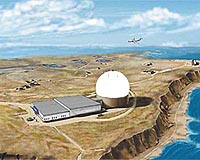 |
Tel Aviv, Israel (UPI) Aug 2, 2010 The United States and Israel have agreed to upgrade Israel's Arrow II anti-ballistic missile into a longer-range version, the Israeli Defense Ministry said. The agreement, which will cost the United States an estimated $100 million, will create the Arrow III missile, designed to intercept incoming missiles from as far away as Iran. Development will take up to four years. The agreement was signed in Tel Aviv by head of Israeli Defense Ministry's MAFAT Research and Development Directorate, Brig. Gen. Ofir Shoham, and the head of the U.S. Missile Defense Agency, U.S. Army Lt. Gen. Patrick O'Reilly. Arrow III, to be jointly produced by Israel Aerospace Industries and Boeing, will join the Iron Dome and Magic Wand systems in providing multi-layer anti-ballistic missile protection. The latest Arrow, the mark II, has been in service since 2000. It has a two-stage, solid-propellant engine with an operational range of 56 to 92 miles. Maximum flight ceiling of the Arrow II is 37 miles and maximum speed is 6,850 mph. Accuracy is said to be within 13 feet of the target. Unit cost is thought to be more than $3 million. When development of the first Arrow program began in 1989, the cost of its development and manufacture, including the initial production of missiles, was estimated $1.6 billion. By 2007 around $2.4 billion had been reportedly invested in the Arrow program, with the United States contributing between 50 and 80 percent. Israel contributes around $65 million annually. The U.S.-Israeli Arrow agreement last month comes after U.S. President Barack Obama in May approved $205 million in special aid for Israel to establish 10 control centers for the Iron Dome system. Late last month Israel's defense ministry said it intends to buy more Iron Dome missile interceptors after it deploys the controversial anti-missile system starting in November. The mobile Iron Dome system, being developed by Rafael Advanced Defense Systems, is designed to intercept short-range rockets and artillery shells especially coming in from the Gaza Strip and Lebanon where Hamas and the Hezbollah have fired thousands at Israel in the past. First deployment will be along the border of the Hamas-run Gaza Strip from where homemade rockets are fired daily into Israel. After deployment along the Gaza border, it will be used along the Lebanese border, where the Israeli government claims Hezbollah has an inventory of more than 40,000 rockets ready to be fired at Israel. Last month Iron Dome intercepted multiple rocket barrages mimicking Qassams and Katyushas, the mainstay of Hamas and Hezbollah attacks. Iron Dome missiles determined which incoming rockets were threats and which were headed toward open fields.
Share This Article With Planet Earth
Related Links Learn about missile defense at SpaceWar.com Learn about nuclear weapons doctrine and defense at SpaceWar.com All about missiles at SpaceWar.com Learn about the Superpowers of the 21st Century at SpaceWar.com
 US to activate missile shield over southern Europe: report
US to activate missile shield over southern Europe: reportWashington (AFP) July 31, 2010 The United States is close to activating a missile shield over southern Europe as part of its effort to shore up regional defenses in the face of a missile threat from Iran, The Washington Post reported late Saturday. Citing unnamed Pentagon officials, the newspaper said the US Defense Department is nearing a deal to establish a key radar ground station probably in Turkey or Bulgaria. ... read more |
|
| The content herein, unless otherwise known to be public domain, are Copyright 1995-2010 - SpaceDaily. AFP and UPI Wire Stories are copyright Agence France-Presse and United Press International. ESA Portal Reports are copyright European Space Agency. All NASA sourced material is public domain. Additional copyrights may apply in whole or part to other bona fide parties. Advertising does not imply endorsement,agreement or approval of any opinions, statements or information provided by SpaceDaily on any Web page published or hosted by SpaceDaily. Privacy Statement |